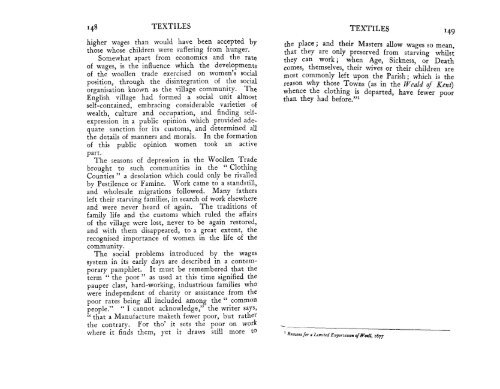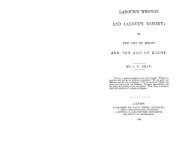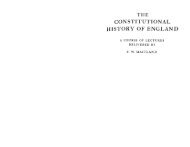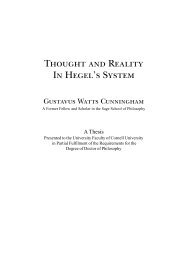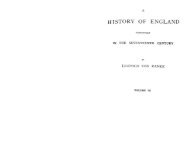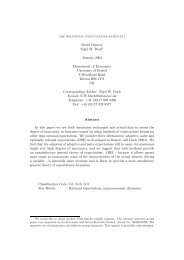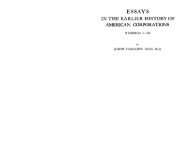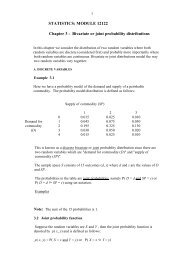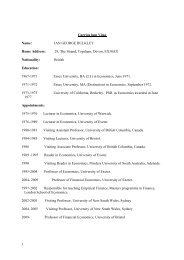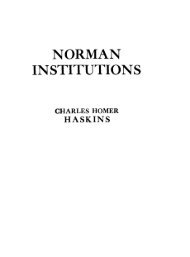TEXTILEShigher wages than would have been accepted bythose whose children were suffering from hunger.Somewhat apart from economics and the rate<strong>of</strong> wages, is the influence which the developments<strong>of</strong> the woollen trade exercised on <strong>women</strong>'s socialposition, through the disintegration <strong>of</strong> the socialorganisation known as the village community. TheEnglish village had formed a social unit almostself-contained, embracing considerable varieties <strong>of</strong>wealth, culture and occupation, and finding selfexpressionin a public opinion which provided adequatesanction for its customs, and determined allthe details <strong>of</strong> manners and morals. In the formation<strong>of</strong> this public opinion <strong>women</strong> took an activepart.The seasons <strong>of</strong> depression in the Woollen Tradebrought to such communities in the " ClothingCounties " a desolation which could only be rivalledby Pestilence or Famine. Work came to a standstill,and wholesale migrations followed. Many fathersleft their starving families, in search <strong>of</strong> work elsewhereand were never heard <strong>of</strong> again. The traditions <strong>of</strong>family <strong>life</strong> and the customs which ruled the affairs<strong>of</strong> the village were lost, never to be again restored,and with them disappeared, to a great extent, therecognised importance <strong>of</strong> <strong>women</strong> in the <strong>life</strong> <strong>of</strong> thecommunity.The social problems introduced by the wagessystem in its early days are described in a contemporarypamphlet. It must be remembered that theterm " the poor " as used at this time signified thepauper class, hard-<strong>working</strong>, industrious families whowere independent <strong>of</strong> charity or assistance from thepoor rates being all included among the " commonpeople." " I cannot acknowledge," the writer says," that a Manufacture maketh fewer poor, but ratherthe contrary. For tho' it sets the poor on workwhere it finds them, yet it draws still more toTEXTILESI49the lace ; and their Masters allow wages so mean,that they are only preserved from starving whilstthey can work; when Age, Sickness, or Deathcomes, themselves, their wives or their children aremost commonly left upon the Parish; which is thereason why those Towns (as in the Weald <strong>of</strong> Kent)whence the clothing is departed, have fewer poorthan they had before."'--l Reasons for a Lrmrted Eqortahon <strong>of</strong> WOO~, 1677
CRAFTS AND TRADESCHAPTER V.--CRAFTS AND TRIZDES.(A) Crafts. Influence <strong>of</strong> Gilds-Inclusion <strong>of</strong> <strong>women</strong>-Position <strong>of</strong> craftsman'swife-Purposes <strong>of</strong> Gilds-The share <strong>of</strong> <strong>women</strong> in religious, social and tradingprivileges-Admission chiefly by marriage-Stationer's Company-Carpenter'mCompany-Rules <strong>of</strong> other Gllds and Companies-Apprenticeship to <strong>women</strong>-Exclusion <strong>of</strong> <strong>women</strong> did not originate in sex jealousy-Position <strong>of</strong> <strong>women</strong> in opentrades-Women's trades.(B), Retarl Trades. Want <strong>of</strong> technical training incl~ned <strong>women</strong> towardsreta11in~-Impediments in their way-Apprenticeship <strong>of</strong> girls to shopkeepers-Prosecution <strong>of</strong> unauthorised traders-Street and market trading-Pedlars,Regraters, Badgers-Opposition <strong>of</strong> shopkeepers.(C) Prwtsion Trades.1. Bakers. Never specially . - a woman's trade-Widows-Share <strong>of</strong>married <strong>women</strong>.z. Mzllers. Occasionally followed by <strong>women</strong>.3. Butchers. Carried on by <strong>women</strong> as widows and by married <strong>women</strong>alsoindependently-Regrating.4. Fzshwietes. Generally vcry poor.5. Brewers. Originally a special <strong>women</strong>'s trade-Use <strong>of</strong> feminine formBrewster-Creation <strong>of</strong> monopoly-Exclusion <strong>of</strong> <strong>women</strong> by the tradewhen capitalised-retailing still largely in hands <strong>of</strong> <strong>women</strong>.6. Vzntners.AGRICULTURE and the textile industries having beenconsidered separately, owing to their importance andthe very special conditions obtaining in both, the otherforms <strong>of</strong> industry in which <strong>women</strong> were employedmay be roughly divided into three classes, accordingto certain influences which made them more or lesssuitable for <strong>women</strong>'s employment.-(a) Skilled Trades.(b) Retail Trades. (c) Provision Trades.(a) The Skilled Trades. Most characteristic <strong>of</strong>the skilled trades are those crafts which became moreor less highly organised and specialised by means<strong>of</strong> Gilds ; though girls mere seldom apprenticed tothe gild trades, yet her marriage to a member <strong>of</strong> theGild conferred upon a woman her husband's rightsand privileges; and as she retained these after hisdeath, she could, as a widow, continue to controland direct the business which she inherited fromher husband. In many trades the gild organisationbroke down, and though the form <strong>of</strong> apprenticeshipwas retained its observance secured few, if any,privileges. Some skilled trades were chiefly if notwholly, in the hands <strong>of</strong> <strong>women</strong>, and these appearnever to have been organised, though long apprenticeshipswere served by the girls who entered them.(b) The Retail Trades. The classification <strong>of</strong> retailtrades as a group distinct from the Skilled Trades andthe Provision Trades is somewhat arbitrary, becauseunder the system <strong>of</strong> Family Industry, the maker <strong>of</strong>the goods was <strong>of</strong>ten his own salesman; or the rniddlemenwho sold the goods to the consumers werethemselves organised into gilds. Nevertheless, fromthe woman's point <strong>of</strong> view retailing deserves separateconsideration, because, whether as a branch <strong>of</strong> FamilyIndustry or as a trade in itself, the employment <strong>of</strong>selling was so singularly adapted to the circumstances<strong>of</strong> <strong>women</strong>, that among their resources it may almosttake rank with agriculture and spinning.(c) The Provision Tmdes also, whether concernedwith the production or only with the sale <strong>of</strong> Provisions,occupy a special position, because the provisioning<strong>of</strong> their households has been regarded from timeimmemorial as one <strong>of</strong> the elementary duties fallingto the share <strong>of</strong> <strong>women</strong>, and it is interesting to notehow far skill acquired by <strong>women</strong> in such domesticwork was useful to them in trade.In all three classes <strong>of</strong> industry <strong>women</strong> were employedas their husbands' assistants or partners, but in themiddle ages married <strong>women</strong> also engaged in businessfrequently on their own account. This was sousual that almost all the early Customs <strong>of</strong> the Boroughsenable a woman, when so trading, to go to lawas though though she were a femme sole, and providethat her husband shall not be responsible for her
- Page 1 and 2:
WORKING LIFE OF WOMENIN THESEVENTEE
- Page 6 and 7:
4 INTRODUCTORYtragic class of wage
- Page 8 and 9:
8 INTRODUCTORY INTRODUCTORYDomestic
- Page 10 and 11:
INTRODUCTORYunmarried girls go out
- Page 12 and 13:
I 6 CAPITALISTS CAPITALISTS" I loos
- Page 14 and 15:
CAPITALISTSweak woman stands in the
- Page 16 and 17:
24 CAPITALISTS CAPITALISTS 25wife t
- Page 18 and 19:
2 8 CAPITALISTS CAPITALISTS 29Majes
- Page 20 and 21:
32 CAPITALISTSA warrant was issued"
- Page 22 and 23:
CAPITALISTSbusiness. " At O~tend, N
- Page 24 and 25:
CAPITALISTS CAPITALISTS41thro' her
- Page 26 and 27:
AGRICULTUREwas made of their develo
- Page 28 and 29: AGRICULTUREis not drye as it should
- Page 30 and 31: 52 AGRICULTURE AGRICULTUREhave of h
- Page 32 and 33: 56 AGRICULTUREfor colonists in Virg
- Page 34 and 35: AGRICULTUREmaintain completely the
- Page 36 and 37: 64 AGRICULTUREtime was well spent i
- Page 38 and 39: AGRICULTUREExcept in exeptional cir
- Page 40 and 41: 72 AGRICULTURE AGRICULTURE 73mainta
- Page 42 and 43: 76 AGRICULTUREfor the impotent poor
- Page 44 and 45: AGRICULTUREwhich we can imagine tha
- Page 46 and 47: AGRICULTURE AGRICULTURE 85by his se
- Page 48 and 49: AGRICULTUREher work, but generosity
- Page 50 and 51: AGRICULTUREwife of Thos. Lyne. Toba
- Page 52 and 53: TEXTILESwas paid better than the la
- Page 54 and 55: TEXTILESroof provided them with the
- Page 56 and 57: 104 TEXTILESformulated by 25 Charle
- Page 58 and 59: 108 TEXTILES TEXTILES 109until the
- Page 60 and 61: TEXTILESon spinning for their livin
- Page 62 and 63: TEXTILESstill and dry within Doors,
- Page 64 and 65: 120 TEXTILES TEXTILESthe cloth made
- Page 66 and 67: 124TEXTILES TEXTILESin the closely
- Page 68 and 69: TEXTILESKingdom, it required a grea
- Page 70 and 71: 132 TEXTILES TEXTILESnot exceedl6 1
- Page 72 and 73: TEXTILES TEXTILES I37hours in four
- Page 74 and 75: ---P-I 4OTEXTILEScan be quoted of t
- Page 76 and 77: '44 TEXTILES TEXTILESWood Streate,
- Page 80 and 81: 1 52 CRAFTS AND TRADESdebts. For ex
- Page 82 and 83: I 56 CRAFTS AND TRADES CRAFTS AND T
- Page 84 and 85: 160 CRAFTS AND TRADES CRAFTS AND TR
- Page 86 and 87: 164 CRAFTS AND TRADESAmong thirty-n
- Page 88 and 89: CRAFTS AND TRADESalso met with as b
- Page 90 and 91: 172 CRAFTS AND TRADES CRAFTS AND TR
- Page 92 and 93: 176 CRAFTS AND TRADESto Henry Joyce
- Page 94 and 95: 180 CRAFTS AND TRADES CRAFTS AND TR
- Page 96: CRAFTS AND TRADESWardens and Brothe
- Page 99 and 100: P-I9OCRAFTS AND TRADESmarriage ; it
- Page 101 and 102: CRAFTS AND TRADEStaken our goods fr
- Page 103 and 104: 1g8CRAFTS AND TRADESresources turne
- Page 105 and 106: CRAFTS AND TRADESThere were fewer r
- Page 107 and 108: 206 CRAFTS AND TRADES CRAFTS AND TR
- Page 109 and 110: CRAFTS AND TRADESA large proportion
- Page 111 and 112: 214CRAFTS AND TRADES CRAFTS AND TRA
- Page 113 and 114: 218 CRAFTS AND TRADES CRAFTS AND TR
- Page 115 and 116: 222 CRAFTS AND TRADES CRAFTS AND TR
- Page 117: CRAFTS AND TRADES CRAFTS AND TRADES
- Page 120 and 121: CRAFTS AND TRADESfrom her fellow pa
- Page 122 and 123: PROFESSIONS 237PROFESSIONSIntroduct
- Page 124 and 125: 24O PROFESSIONS PROFESSIONStheir Th
- Page 126 and 127: 244 PROFESSIONS PROFESSIONS 245the
- Page 128 and 129:
PROFESSIONS PROFESSIONS 249profanat
- Page 130 and 131:
252PROFESSIONSGiles Moore enters in
- Page 132 and 133:
PROFESSIONScribed as one who " dist
- Page 134 and 135:
PROFESSIONS PROFESSIONS 261first ma
- Page 136 and 137:
264 PROFESSIONSGarrett's leg shall
- Page 138 and 139:
268 PROFESSIONSwhere there are none
- Page 140 and 141:
PROFESSIONS PROFESSIONS 273the numb
- Page 142 and 143:
PROFESSIONSexaminations, before six
- Page 144 and 145:
PROFESSIONS PROFESSIONS 281death me
- Page 146 and 147:
284 PROFESSIONS PROFESSIONSof confi
- Page 148 and 149:
288 PROFESSIONSextent they were whe
- Page 150 and 151:
CONCLUSIONor in her other facilitie
- Page 152 and 153:
CONCLUSION CONCLUSION 297in women's
- Page 154 and 155:
CONCLUSIONlaw of Nature, inviolable
- Page 156 and 157:
CONCLUSIONwere specially deprecated
- Page 158 and 159:
308 CONCLUSIONof the State, and the
- Page 160 and 161:
312 AUTHORITIES AUTHORITIES 313Cost
- Page 162 and 163:
AUTHORITIESMartindale, Adam, The Li
- Page 164 and 165:
County.Buckingham ..Cardigan .. ..C
- Page 166 and 167:
INDEXINDEXFlax, 64, 146, 246, 291 ;
- Page 168:
INDEXsmants, women( 50,65,157 ; mam


